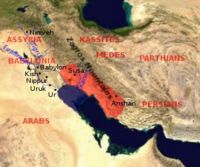Lesson 37
Thou Hast Done Wonderful Things (Isaiah 22; Isaiah 24–26; Isaiah 28–30)
Contents
Church Cirriculum
The official church guide can be seen at the Official LDS Church site for Gospel Doctrine
We encourage you to make sure you are familiar with the official church curriculum as the first step in your lesson preparation, as this is the material recommended by the General Authorities of the church.
Supplementary material here is not intended to substitute for lesson preparation, but hopefully it will enhance your preparations for Sunday School.
Teaching Ideas
There are a few ways to approach this lesson. In this lesson, the church manual has a big emphasis on scriptures that relate specifically to the prophecies, life, and ministry of Jesus Christ. There are many scriptures in Isaiah relating to this topic, and certainly this is an excellent way to show that Isaiah spoke frequently about the coming Messiah.
For a historical background, refer to Lesson 36 and Isaiah to understand what is going on in the days of Isaiah. Many people, both in and outside the church find the words of Isaiah difficult to understand, and there is another way to approach these chapters. Many have found that other translations have been helpful, and the prophet Joseph Smith was known to consult other translations of the bible to help in understanding.
In Teachings of the Prophet Joseph Smith, on page 349 he said I have an old edition of the New Testament in Latin, Hebrew, German, and Greek languages. I have been reading the German, and find it to be the most (nearly) correct translation, and to correspond nearest to the revelations which God has given to me for the last fourteen years.
Most of us can't read German, or any other foreign language. Some may find other easier to read editions of the english bible helpful in understanding. In the links below, there is an excellent book by David J. Ridges, a religion teacher at BYU, on the Old Testament. He also wrote a book specifically on Isaiah. Both books contain essentially the same information with regards to Old Testament Isaiah. Brother Ridges uses the King James Version, and then offers an "up to date" translation" to aid in understanding. The book is a great resource for understanding Isaiah's writings in the same narrative way as the book is written, as opposed to the church manual's way of only pulling scriptures out that relate to the divinity of Jesus Christ.
An excellent resource on the web is the Blue Letter Bible. It contains 13 different translations, and you can compare any verse to any of the 13 translations, including the Latin Vulgate (helpful if you can read Latin.) If you would like to go directly to the beginning of this lesson, here is a sample of Isaiah 20:1 with its various translations. Some may find the NLT version one of the easiest versions to understand, but feel free to browse the different translations to see if you prefer another version.]
Key Terms
Elamites
Elamites were considered the offspring of Elam son of Shem (Genesis 10:22, Ezra 4:9). They could be considerded Semites, but their language was not considered semetic. According to Easton's Bible Dictionary (1897) they lived in the Iranian plain. Babylonia was frequently invaded by the Elamite kings, who at times asserted their supremacy over it (as in the case of Chedorlaomer, the Kudur-Lagamar, or ‘servant of the goddess Lagamar,’ of the cuneiform texts).
“The later Assyrian monarchs made several campaigns against Elam, and finally Assur-bani-pal (about B.C. 650) succeeded in conquering the country, which was ravaged with fire and sword. On the fall of the Assyrian Empire, Elam passed into the hands of the Persians” (A.H. Sayce).
This country was called by the Greeks Cissia or Susiana.
Additional Teaching Materials
- Prophets. A&E Home video. Chapter 4. 1994. ISBN 0-7670-8501-9.
- Old Testament Institute Manual
- The Old Testament Made Easier Part 3. David J Ridges, 2006. ISBN 1-55517-957-6
- Isaiah Made Easier in the Bible and the Book of Mormon. David J Ridges, 2002. ISBN 1-55517-615-1
- Comparative Study Bible. Zondervan, 1999. ISBN 0310903335. (NIV, King James Version, NASB Updated, and Amplified side-by-side)
External Links
- Blue Letter Bible, can compare up to 13 different translations, along with bible commentaries.
- Easton's Bible Dictionary
